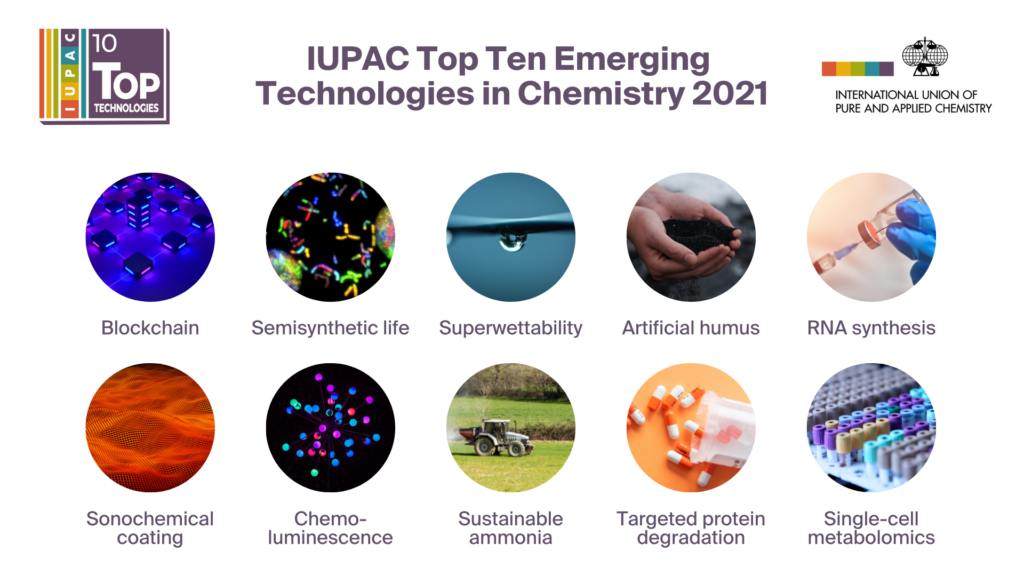The International Union of Pure and Applied Chemistry (IUPAC) has released the results of the search for the 2021 Top Ten Emerging Technologies in Chemistry. The goal of this project is to showcase the transformative value of Chemistry and to inform the general public on the potential of the chemical sciences to foster the well-being of Society and the sustainability of our Planet. The Jury, a selection of international experts, identified different emerging technologies, scientific advances in between a discovery and fully-commercialized ideas, with outstanding capacity to open new opportunities in chemistry, sustainability, and beyond.
 The 2021 finalists are (in alphabetical order):
The 2021 finalists are (in alphabetical order):
• Artificial humic matter from biomass
• Blockchain technology
• Chemiluminescence for biological use
• Chemical synthesis of RNA and DNA
• Semi-synthetic life
• Single cell metabolomics
• Sonochemical coatings
• Superwettability
• Sustainable production of ammonia
• Targeted protein degradation
IUPAC Vice President, Professor Javier García Martínez, said that “In the last months, we have witnessed how vital chemistry is in facing and overcoming our most pressing challenges. Moving forward, these threats will only be more complex and unpredictable. In this regard, the recent IPCC report alerts us to the risk posed by climate change for our survival. With the Top Ten Emerging Technologies in Chemistry, IUPAC provides a fresh look at technologies that are already creating new opportunities and opening new avenues for research and industry. I hope this year’s edition arouses the same interest and attention as previous IUPAC Top Ten selections.”
The 2021 Top Ten Emerging Technologies in Chemistry are further detailed in an open-access feature article published in the October issue of Chemistry International. Fernando Gomollón-Bel, the author, remarks: “While highlighting breakthroughs for a circular, climate-neutral future, the selected IUPAC Top Ten technologies will change our world for the better, making a more thoughtful use of our resources, favoring more efficient transformations, and providing more sustainable solutions in applications.”
The article is published in the October 2021 issue of IUPAC magazine Chemistry International and freely-available at the following link: https:// bit.ly/IUPACTop2021.
The Jury* was an international group of objective and unbiased experts who reviewed and discussed a pool of nominations, and ultimately selected the final top ten.
The first selection of Top Ten Emerging Technologies in Chemistry was released in 2019 as a special activity honoring IUPAC’s 100th anniversary; the results were published in the April 2019 (Chem. Int., 41(2), pp. 12-17, 2019; https://doi.org/10.1515/ci-2019-0203). The 2020 results were published in October 2020 (Chem. Int. 42(4) pp. 3-9, 2020; https://doi.org/10.1515/ci-2020-0402).
Note that this year’s Nobel Prize in Chemistry was awarded to Benjamin List and David MacMillan for the development of asymmetric organocatalysis – one of the Top Ten Emerging Technologies in Chemistry selected in 2019. Freely available in the IUPAC journal Pure and Applied Chemistry is a special topic paper by Benjamin List entitled “Organocatalysis Emerging as a Technology,” see: https://doi.org/10.1515/pac-2021-0501.
The next search for the Top Ten Emerging Technologies in Chemistry has already begun and will be led again by Prof. Dr. Michael Droescher, Treasurer and General Secretary of the German Association for the Advancement of Science and Medicine. Droescher served as a judge for the initial search and as chair of the Jury for both the 2020 and 2021 searches. For more information on the search for the 2022 Top Ten Emerging Technologies in Chemistry go to: https://iupac.org/what-we-do/top-ten/.
*The following comprised the panel of judges for the 2021 Top Ten Emerging Technologies in Chemistry: Chair, Michael Droescher, (German Association for the Advancement of Science and Medicine), Jorge Alegre-Cebollada (Centro Nacional de Investigaciones Cardiovasculares, Spain), Sophie Carenco (French National Center for Scientific Research, France), Javier García Martínez (Universidad de Alicante, Spain), Ehud Keinan (Technion, Israel), Rai Kookana (CSIRO Land & Water, Australia), Greg Russell (University of Canterbury, New Zealand), Ken Sakai (Kyushu University, Japan), Natalia P. Tarasova (D. I. Mendeleev University of Chemical Technology, Russia), and Bernard West (Life Sciences Ontario, Canada). Many thanks to Bonnie Lawlor for all her valuable corrections and contributions that enhanced the quality of this article.
About IUPAC: Founded in1919 by academic and industrial chemists as a neutral and objective scientific organization, the International Union of Pure and Applied Chemistry (IUPAC) is the world authority on chemical nomenclature and terminology, including the naming of new elements in the periodic table; on standardized methods for measurement; and on atomic weights, and many other critically-evaluated data. It was founded with the goal of uniting a fragmented, global chemistry community in order to advance the chemical sciences through collaborative efforts and the free exchange of scientific information. For more than a century IUPAC has fulfilled that goal through the creation of a common language, the standardization of processes and procedures and many diverse and global activities that ultimately impact both the chemical profession and Society as a whole. For more information on IUPAC go to: https://iupac.org/.


